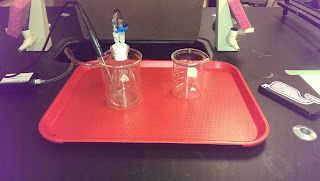Over the past week, we learned about changes in mass and the exploding paint can. These main ideas connect with each other because the exploding paint can was a change of mass. Most of the changes of mass were caused by chemical reactions but some of the changes of mass stayed the same. We performed six experiments to see the change in mass and one experiment as a class for the exploding paint can.
Exploding Paint Can We filled a small and a big paint can with methane, which is a gas lighter than air itself, and lit it on fire. In the beginning, the flame was blue at the bottom and fading to red and yellow near the top. As the fire started to die, the flame became more of a blue little bulb. When the fire finally died, the paint cans both made a loud bang that startled most of us. For the small paint can, it jumped off the table and fell onto the floor. However, for the big paint can, it only tilted, the reason might be that the can wasn't sealed tightly enough.
Station 1 We first massed a pie tin and used it to mass a piece of steel wool. Then we pulled apart the steel wool and massed it again. We thought that the mass would stay the same, mainly because no particles were lost or gained. As it turned out, the pulled apart steel wool was lighter than the original by 0.2 grams, most likely because when we were pulling it apart, bits of the steel wool didn't land in the pie tin, therefore attributing to the lighter mass.
 |
| whiteboard of the particles of the steel wool and pulled apart steel wool |
Station 2 We first massed the pulled apart steel wool in a pie tin. We then picked up the pulled apart steel wool with a pair of tongs and placed the burner in the pie tin. Then we lit the burner and passed the steel wool in and out of the flame. As the steel wool was burning, flakes of it fell off and it turned a dark blue color. Before we burned steel wool, it had a mass of 5.612 grams. After we had burned the steel wool, it had a mass of 6.1 grams. I thought that the steel wool would get lighter, but in contrast, it grew heavier by 0.488 grams, due to the chemical reaction that happened.
 |
| steel wool before being burned |
 |
| steel wool after being burned |
 |
| steel wool being burned |
Station 3 We first found the mass of the vial and ice. We then warmed the vial in our hands to speed up the melting. After the ice was melted, we massed the water and vial. The mass of the vial and ice was 10.6 grams. The mass of the water and vial was 10.5 grams. The ice and the water should've been the same mass because no chemical changes were made. The human error that may have occurred is that we forgot to zero our scales.
Station 4 There was vials of blue-colored CaCl2 and clear Na2CO3. We first massed CaCl2 and Na2CO3 together. We then combined the two solutions together and massed the mixture. The mixture turned out a cloudy blue. The mass of the two solutions was 53 grams. The mass of the mixture was 41.3 grams. The result was the mixture being heavier than the separate vials by 11.7 grams, which was caused by a chemical reaction from the two solutions.
 |
blue-colored CaCl2 and clear Na2CO3
 |
| The cloudy blue mixture |
|
Station 5 We first filled a vial with water and put a sugar cube in the cap. We then massed the vial with the water and cap with sugar. Then we gently shook the vial and watched the sugar dissolve. Finally, we massed the dissolved sugar solution. The mass of the sugar vial before it was dissolved was 45.23 grams. The mass of the dissolved sugar vial was 45.23 grams. The sugar vial before it was dissolved turned out to be the same mass as the dissolved sugar vial because no chemical change was added.
Station 6 We first filled a vial halfway with water and a fourth tablet of alka-seltzer in the cap of the vial. We then put the cap and vial on the balance to mass it out. Then we put the alka-seltzer in the water, watched it dissolve, and then massed it. The mass of the vial and cap before the alka-selzter 34.96 grams. The mass of the dissolved alka-seltzer in the vial and cap was 33.88. The change in mass was -1.08 grams. I was taken aback by this result because I thought it would increase in mass because two separate materials were combined. It may have decreased because of the bubbles making it lighter.
 |
| dissolved alka-selzter in vial |
We came to know and understand the ideas we learned this week by performing experiments and making charts and histograms based off out data. Another thing we did was share our ideas on whit boards and had discussions about that topic.
 |
our data for station 1 (left)
our histograms for station 1 (right) |
Questions I still have is why the burned steel wool had more mass than the original. I participated okay this week because there were some moments where I got distracted. If I had to rate my understanding of all the ideas from this class, I would rate myself an 8.5 because I understand most of the concepts, I just have a few questions. I need to work on staying more focused and organised.
















































